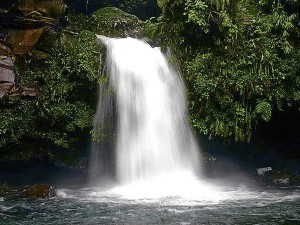
Sarap ng feeling probinsya! That’s the charm and the appeal of Banahaw towns. There’s a lot of old world naturalness, freshness and cleanliness in the air you breathe in Majayjay, Lucban and Liliw. These towns nestle at the foot of Mount Banahaw.
They are cold towns, with an all-day and all-night cool breeze blowing from mountains, chilly air after midnight and misty mornings. At times, the surrounding hills, meadows and forests are veiled in fog.
The rainfall is high. Seven months of rain and afternoon drizzle make the land fertile, its meadows, rainforests, hills and terraced rice paddies forever lush and green.
All towns have crystal clear mountain springs and babbling brooks running under old bridges. The streets are narrow and houses are close to each other.
Majayjay is rustic and laidback, retaining the slow and easy lifestyle of the past, its charming people ready to welcome you with a curious smile and the readiness to befriend and help.
Liliw’s main street is a marketplace crowded with out-of-town shoppers. The town folks are engaged in making beautiful leather footwear at incredibly affordable prices.
Lucban is the town for food and handicrafts. It’s famous for its festival featuring farm harvests called Pahiyas, which is celebrated every May 15.
‘Filipino-ness’
The “Filipino-ness” in hometown communities is evident in Lucban and Majayjay (my hometown), Liliw and Nagcarlan, including the lake towns of Lumban and Paete. These are all scenic towns bejeweled by Mother Nature: all forested, all fresh and all green connected by hills, gorges, valleys, lakes and plateaus magical to behold.
From big Mt. Banahaw gushes forth myriad virgin springs, rivulets of crystalline waters to form streams, brooks, river gorges, waterfalls and lagoons, all byways and enchanted patches of earth in the Laguna-Quezon border. Lake towns Lumban, Pagsanjan and Paete get their cold fresh air from the winds of Laguna Lake and the mountain ranges on the Pacific Ocean side.
The habitat breeds creativity like birthing rabbits. The wood sculptors and painters of Paete, the embroidery artists of Lumban. The agro-based house frontispiece decor of Lucban’s Pahiyas, the beautiful footwear and leather accessories of Liliw are creations of indigenous designers and craftsmen.
Mt. Banahaw and Laguna Bay old towns are excellent eco-tourism destinations nearest to Manila. Majayjay rain forest waterfalls and the rivers of Liliw and Nagcarlan are still in their pristine form. The more upwards to Mt. Banahaw the trek, the more pre-historic. Old churches still ring their big cast iron bells, and narrow streets provide the quaintness and patina of history.
The town folk are proud of their cuisine. Lucban is tops with their hardinera meat loaf, garlicky and vinegared longganisa, and the famous street food called by the way it’s eaten, pancit habhab. Majayjay’s tinutong laing and pako salad are to die for. Liliw’s uraro is a melt-in-the-mouth cookie. Nagcarlan’s wet market carries the best glutinous rice sweet delights. Newly harvested vegetables and fruits are raised by savvy farmers in the uplands of Mt. San Cristobal. Fish vendors hawk black tilapia from Kalibato Lake, which is the tastiest of all tilapia, with big and fat dalag excellent for luscious pesa broth.
Town celebrations are colorful and transcendent with the vibrancy of Christianity. They are crowd drawers and veritable pageantries: Pakil’s Birhen de Turumba’s jump for joy procession and the fluvial festivities of Lumban and Pagsanjan. The Flores de Mayo and Holy Week processions of Majayjay, Liliw, and Pagsanjan dramatize our Filipino culture and celebratory Catholicism.
Healing shrine
The dawn Easter Pasalubong procession in Paete is unique with rhyming couplet dialogue between the risen Jesus and his blessed mother. Lucban’s Kamay ni Hesus is a healing shrine on a hill where pilgrims go praying for cures.
I always go to these towns to savor their cuisine, gaze at their arts, pray in their old churches, revel in their festivities, at all times enjoying the love and care of relatives and friends living there.
From the peaceful, quiet, and family value-oriented communities 50 years ago, these towns have grown and created their own unique bustle. Main streets have become shopping and fine dining streets (try Liliw’s Arabella for pastas and pastries, Lucban’s Buddy’s for hardinera and habhab) full of locals, out-of-towners, urbanities from the middle class Manila and Makati enclaves, balikbayan who want to feel Filipino in its original state, groups of Koreans, Japanese and the archetypal western tourists.
Some things don’t change in spite of progress. The ancient church bells still toll at the start of mass, the narrow street with umpukans and tagayans (old guys making tsismis by the road with fiery lambanog on the side), the singsong accent of the natives, their open smiles towards strangers and that cool mountain air one breathes are all part of the old world charm.
“Small is Beautiful,” the bestseller book written by economist E.F. Schumacher on “economics as if people mattered,” professes that local culture, people’s creativity, human spirituality, and indigenous products and services are the foundations for the self-sufficient Ghandian village model, free standing enough to avoid over-consumption and untrammeled materialism.
The human benefits are visible, felt, and enjoyable for the ordinary people, as seen in their excellent work and easy smiles.
When you’re in Laguna’s mountain towns, take a deep breath. It’s the freshest thing you’ll feel outside of the smoldering concrete urban jungle.
E-mail the author at [email protected].









































